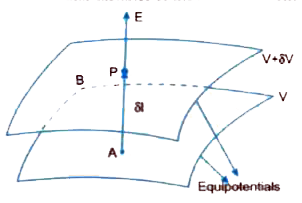Two closely spaced equipotential surfaces A and B with potentials V and V+δV (where SV is the change in V) are kept 8l distance apart as shown in the Fig. Deduce the relation between the electric field and the potential gradient between them. Write the two important conclusions concerning the relation between the electric field and the electric potential.

Text Solution
Consider two closely spaced equipotential surfaces A and B, having uniform potentials V and V + δV in the direction of the electric field E. Let δl be the perpendicular distance of the surface A from a point P on surface B.
If we consider that a unit +ve charge is moved along this perpendicular from surface B to surface A against the electric field then work done
δW=EδI
By definition the work done equals the potential difference
(VA−VB)=V−(V+δV)=δV
⇒EδI=−δVorE=−δVδI(or−dVdl)
For two important conclusions.
|
Topper's Solved these Questions
- ELECTROSTATIC POTENTIAL AND CAPACITANCE BOOK - U-LIKE SERIESCHAPTER - ELECTROSTATIC POTENTIAL AND CAPACITANCE EXERCISE - LONG ANSWER QUESTIONS-I
64 Videos
- ELECTROSTATIC POTENTIAL AND CAPACITANCE BOOK - U-LIKE SERIESCHAPTER - ELECTROSTATIC POTENTIAL AND CAPACITANCE EXERCISE - LONG ANSWER QUESTIONS-II
13 Videos
- ELECTROSTATIC POTENTIAL AND CAPACITANCE BOOK - U-LIKE SERIESCHAPTER - ELECTROSTATIC POTENTIAL AND CAPACITANCE EXERCISE - VERY SHORT ANSWER QUESTIONS
40 Videos
- ELECTROMAGNETICE INDUCTIONBOOK - U-LIKE SERIESCHAPTER - ELECTROMAGNETICE INDUCTIONEXERCISE - Self Assessment Test Section -D
1 Videos
- EXAMINATION PAPER 2020 (SOLVED)BOOK - U-LIKE SERIESCHAPTER - EXAMINATION PAPER 2020 (SOLVED)EXERCISE - SECTION D
6 Videos
Similar Questions
Knowledge Check
The correct relation between electric intensity E and electric potential V is
AE=−dVdrBE=dVdrCV=−dEdrDV=dEdrWhat do you understand by potential gradient ?
Establish a relation between electric field and potential gradient.AElectric field is in the direction in which the potential decreases steepestBMagnitude of electric field is given by the charge in the magnitude of potential per unit displacement jnormal to the equipotential surface at the point.CIn the region of strong electrric field, equipotential surfaces are far apart.DBoth the statements (a) and (b) are correct.In the region where electric field E=0, the relation between electirc potential V and distance r is
AV∝rBV∝1/rCV∝r2DV= constant
Relation between electric potential (V) and Intensity (E)
View SolutionWhat do you understand by potential gradiednt ?
Establish a relation between electric field and potential gradient.
View SolutionRelation between Electric Field And Potential|Potential Due To Sphere|OMR
View SolutionEstablish relation between electric field and potential gradient.
Or
Derive relationship between Electric field intensity and potential gradient at a point in the electric field.
View SolutionRelation Between Electric Field And Potential|Practice Questions On Relation Between Electric Field And Potential|Electric Dipole
View Solution
